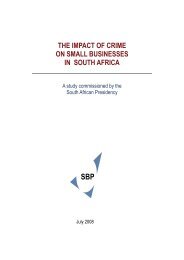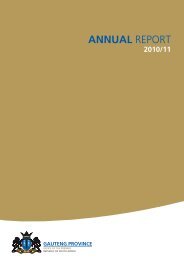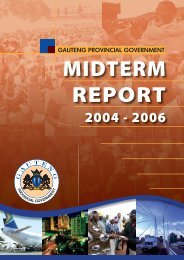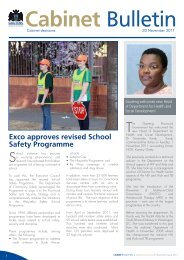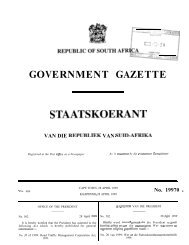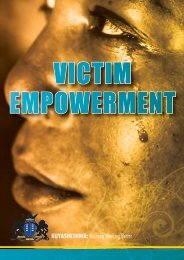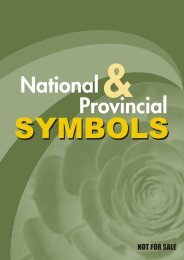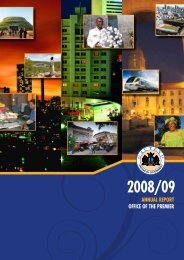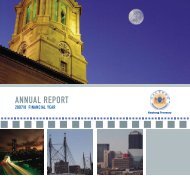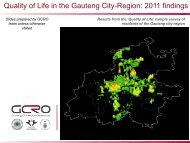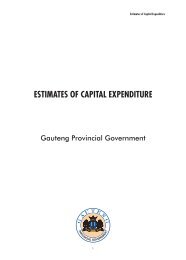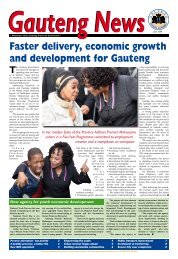the gauteng spatial development framework - Gauteng Online
the gauteng spatial development framework - Gauteng Online
the gauteng spatial development framework - Gauteng Online
You also want an ePaper? Increase the reach of your titles
YUMPU automatically turns print PDFs into web optimized ePapers that Google loves.
<strong>development</strong> <strong>framework</strong> around which policy, infrastructural investment, economic andsocial programmes, urban management, public transport and various subsidies may beharmonised.• increasing <strong>the</strong> intensity of urban form and <strong>the</strong> complexity of mixed-use <strong>development</strong>with a view to restricting, as far as possible, <strong>the</strong> options to extend <strong>the</strong> present footprintof <strong>the</strong> province's urban spread; andIt is essential to have a robust <strong>development</strong> <strong>framework</strong> to cope with variable and nonprescriptivegrowth. The extent and nature of urban growth is a particular challenge formoving into an uncertain urban future, particularly in an urban context, when <strong>the</strong> prognosisfor <strong>the</strong> <strong>Gauteng</strong> City Region (GCR) is that it is likely to be one of <strong>the</strong> significant three orfour megacities of Africa. Whe<strong>the</strong>r this growth, as some projections suggest over a 40- to50-year time horizon, takes <strong>Gauteng</strong>'s population to of <strong>the</strong> order of 30 million people (SaoPaolo and Santos as a conurbation is now approaching 28 million people), or 15 to 20million, <strong>the</strong> fact of <strong>the</strong> matter remains that <strong>Gauteng</strong>'s population is already 11.5 millionpeople, thus an emerging megacity, and <strong>the</strong>re is a need to restructure <strong>Gauteng</strong>'s urbansystem accordingly. This means focusing on key structural issues in achieving an urbansystem that is complex in its nature and make-up and sustainable in its robustness.The GCR aims to develop as a significant emerging conurbation based on sustainableprinciples:• promoting a democratic urban order in terms of access to opportunity for all.In achieving <strong>the</strong>se, <strong>the</strong> GCR will become more nationally and globally competitive and growa sustainable urban economy that supports quality of life and inclusion for all its citizens.At present, <strong>the</strong> GCR does not perform well in respect of <strong>the</strong>se sustainability principles andit is noted that things have become worse in that:• <strong>the</strong> space economy and correction of <strong>the</strong> 'apar<strong>the</strong>id city' has not been addressedvigorously enough; instead it is being reinforced;• <strong>Gauteng</strong>'s economy is visibly divided between <strong>the</strong> first and second economy, <strong>the</strong>latter largely characterized as informal, marginalised, unskilled, unemployed andunemployable;• significantly reducing reliance on private mobility in favour of safe, convenient andaffordable public transport and non-motorised transport;• significantly reducing present rates of non-renewable energy usage;• income inequality in <strong>Gauteng</strong> is higher than in <strong>the</strong> rest of South Africa;• <strong>Gauteng</strong>'s Gini coefficient (measure of inequality) is growing, indicating that <strong>the</strong> richare getting richer and <strong>the</strong> poor are getting poorer; and• reducing <strong>the</strong> rates of energy expended in <strong>the</strong> manufacture of goods, <strong>the</strong> deliveryof <strong>the</strong>se goods to <strong>the</strong> market and <strong>the</strong> importation of goods;• <strong>the</strong> rising level of unemployment (above 20%) is largely structural in nature, meaningthat <strong>the</strong> unemployed struggle to adjust to changes in wage rates and economic activity.SECTION 1: INTRODUCTION• integrating open space systems into <strong>the</strong> city region and providing sustainable ecosystems, Clearly, <strong>the</strong>re is a need to transform <strong>the</strong> very structure of <strong>the</strong> GCR and project strongurban agriculture and quality of life as a fundamental of <strong>the</strong> province'sleadership at provincial level in order to direct metropolitan, district and local municipalities<strong>development</strong> patterns;in achieving vital transformations.1. Mo<strong>the</strong>rhood-and-apple-pie' is an idiom referring to general statements of broad intent but lacking in any real content and representing sentiment without cogent directive.03GAUTENG SPATIAL DEVELOPMENT FRAMEWORK 2011GAUTENG GROWTH AND DEVELOPMENT AGENCY



